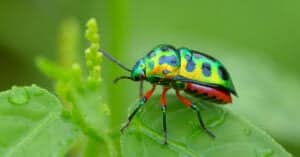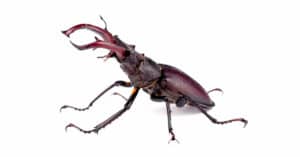One of the biggest threats to an orderly garden is the Japanese Beetle. If you’re a gardener, you’re aware of Japanese beetles and the damage they can do. These Beetles feed on 300 different plants and chances are you will have some of them in your garden. Fortunately, there are ways to get rid of them naturally, such as the Japanese Beetle Traps, and protect your plants. Knowing how and when to use the right methods is key.
There is a lot of debate surrounding the Japanese Beetle Traps and whether it is an effective method to ward off the Beetle problem or not. Here we will look at the pros and cons of the Japanese Beetle Traps and few other natural methods to get rid of Japanese Beetles.
What Are Japanese Beetles?
Japanese beetles (Popillia japonica) are invasive insect species that periodically become major pests. These beetles are voracious eaters of crops, but they also regularly attack roses and other garden flowers.
Why You Need To Get Rid of Japanese Beetles
As its name suggests, this beetle originated in Japan. It was first spotted in the United States in 1916 in a tree nursery in New Jersey. At the time, efforts to eradicate the species consisted of using lead arsenic and cyanide for two years. Through the 1960’s, chemicals were used on a large scale to try and get rid of them, to no avail. Every few years, they increase in number and swarm our fields and flowers.
These bugs are dangerous at every stage of their lives. The larvae destroy grassroots and turf, while the adults eat shrubs, plants, flowers, and trees. Adult beetles eat more than 300 types of plants.
Best Ways To Get Rid of Them
There are three steps to getting rid of these beetles. They are as follows:
- Remove them directly from your plants.
- Spray them with a natural pesticide.
- Use a Japanese beetle trap.
Doing all of these in combination will help you control these dangerous, invasive pests.
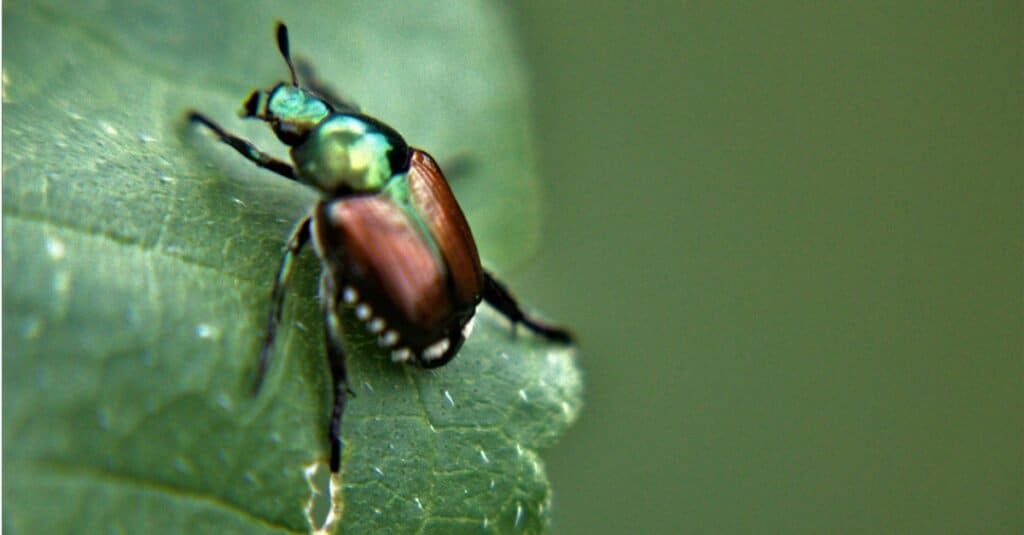
©iStock.com/Justin Tahai
What Does a Japanese Beetle Look Like?
A Japanese beetle is typically ¼ to ½ an inch long. It has a bright green body with brown wings and black legs. The beetle has five tufts of white hair on both sides of its abdomen.
Its larvae are white, C-shaped grubs that can grow to one inch. Japanese beetles lay their eggs in late summer and early fall. Their larvae hatch about 10 days later and begin feeding on grassroots.
Natural Predators
The Japanese Beetle has several natural predators. Their main predator is the tachinid fly (Diptera). Although it looks like a regular fly, it is extremely good at controlling Japanese beetle populations because it eats both the larvae and the adults. Tachinid flies are efficient predators who help control caterpillars, sawfly larvae, earwigs, grasshoppers, and other insects. There are more than 1,500 tachinid fly species.
Birds
Birds that eat Japanese beetles include meadowlarks and cardinals. Starlings, crows, seagulls, and grackles eat both the larvae and the adult bugs.
Mammals
Opossums, raccoons, skunks, moles, and shrews will also chow down on Japanese beetle grubs, but they may damage your lawn in digging them up. In any case, you can’t rely on predators to naturally control an infestation. For that, you must remove the bugs manually, use pesticides and hang Japanese beetle traps.
How To Control Japanese Beetles Naturally
Some people don’t want to use toxic chemicals in their gardens. Pesticides have been strongly linked to many health and environmental concerns, so it’s best to use nontoxic methods.
Homemade Pesticide
Simple soap and water will kill these bugs. If you see these bugs on your plants, fill a large-mouthed bottle with soap and water. Shake it to create a foamy texture. This homemade “poison” is the safest substance to use on them.
Wipe Method
To kill the bugs, wipe them directly off the leaves and into the bottle. They are slow-moving bugs that are quite easy to catch. The best time to do this is in the morning. These bugs typically take a few hours to become fully alert.
Wear gloves while you do this. The bugs won’t bite, but you may smear them while you’re sliding them into the bottle.
The soapy water will kill them, but you can also use a non-chemical, organic pesticide if you want to be sure you kill them. If you have too many bugs to control this way, consider using a Japanese beetle trap.
Pros and Cons of the Wipe Method
This method is simple and requires no toxins or pesticides. However, it may not be enough to manage a large infestation.
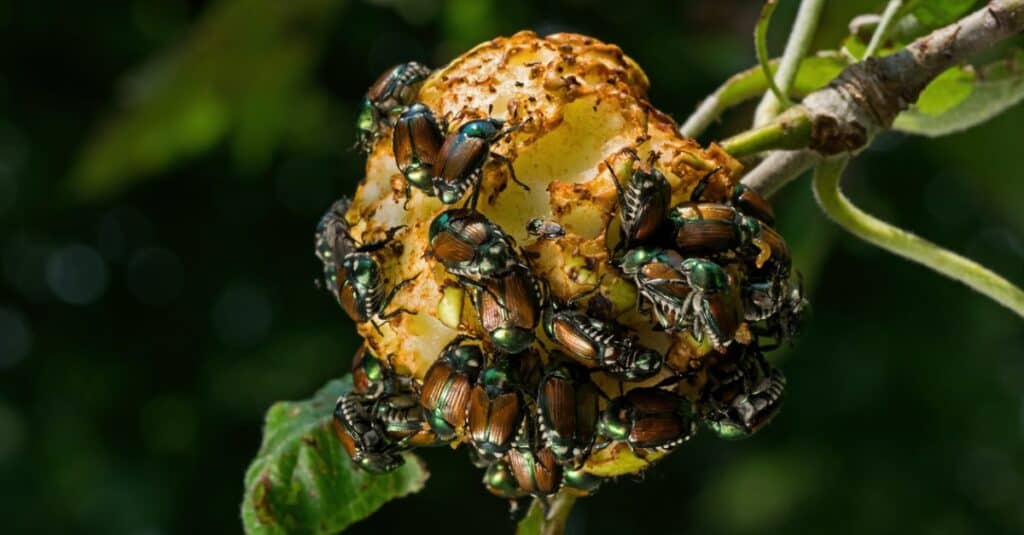
©iStock.com/McKinneMike
Which Pesticides Kill Japanese Beetles?
Fortunately, you can kill these bugs with affordable, widely available, and 100% natural pesticides.
Pyrethrin: Pyrethrin is the active ingredient in many topical flea treatments. It is derived from chrysanthemums and is safe to use on vegetables, fruits, berries, roses, trees, and shrubs. Pyrethrin penetrates the insect’s nerve system and prevents it from moving.
Neem oil: This oil has an active pesticide. It comes from a tree that is native to India. Neem oil does not kill insects on contact. It works three ways. First, it causes them to stop feeding. Second, it interrupts the insect life cycle. Third, it makes them unable to reproduce.
How and when to use pesticides:
- Use it when you have a visible infestation.
- Spray the poison directly on the beetles.
- Avoid spraying it on beneficial insects.
- Wear protective gloves when you use pesticides.
Pros and Cons of Using Pesticides
These pesticides are safe and non-toxic but don’t use them on beneficial insects or in your soil.
Why You Should Use Japanese Beetle Traps
While directly killing the bugs is a good method, you can’t spend all your time in your garden or field looking for these bugs. Japanese beetle traps will do some of the work for you.
How Do Japanese Beetle Traps Work?
Typically, a trap has a thick, plastic bag with an hourglass shape. A set of plastic bars at the top keep the top of the bag open. The bottom of the Japanese Beetle Trap contains the lure. Which is mostly the smell of flower or leaves that is preferred by the Japanese Beetles, or pheromones, or a combination of both that attracts the Japanese beetles like a moth to flame. When they enter the bag and try to reach the lure, they fall down the shaft and into the bottom part of the bag. They can’t escape, so you can easily get rid of them.
Where and When To Use the Japanese Beetle Traps
The best place to put your beetle traps is a good distance from your garden. Many expert gardeners recommend hanging them 30 feet from your garden. Otherwise, the strong scent of the lure may attract beetles and create a new infestation.
- Only use them if you have too many to remove manually.
- Put the bag 30 to 50 feet away from your garden.
- Check the bag regularly.
- Once the bag is full, tie it and throw it in the trash.
How To Empty the Japanese Beetle Traps
When your bag is full, the beetles will usually die of starvation. Now, you must get rid of them.
- Dump the bag in a pail of soapy water to kill the bugs.
- Get rid of the dead bugs. You can bury them in your garden or put them in your trash.
- Wash the bag and reuse it.
- Alternatively, you can throw the bag away and replace it with a fresh one.
Pros and Cons of Using Japanese Beetle Traps
Just like anything else, there is both good and bad sides to using the Japanese Beetle Traps.
Pros:
- These traps work well, but it’s important to place them carefully.
- Placing them directly in your garden can attract beetles and create a new infestation.
- They can help you manage large infestations.
- It’s worth it, however, if you want to get rid of these beetles.
Cons:
- There have been issues of more beetles being attracted to the garden because of the smell of of pheromones.
- The Japanese Beetle Trap wont work if your garden or yard is surrounded by other gardens, yards or forests, rivers, streams etc. It will just attract more Japanese Beetles.
- Dealing with the insects after they have gathered inside the traps could be troublesome.
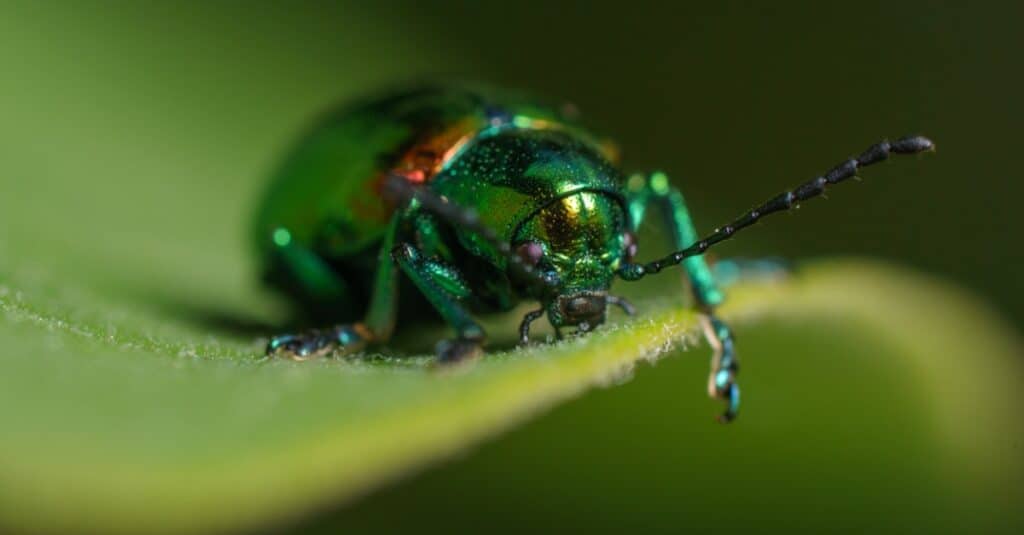
©iStock.com/Credit:RJG Digital Arts
What is the Best Thing to Keep Japanese Beetles Away?
Neem oil provides effectiveness for a few days, but it requires repeated applications. While neem oil can help deter Japanese beetles, its efficacy diminishes when dealing with larger populations. Importantly, this product poses minimal risk to bees and other beneficial insects.
Additionally, to help stop Japanese beetles from your garden, consider planting companion plants.
These companion plants include:
- Catnip
- Chives
- Garlic
- Odorless marigold
- Nasturtium
- White Geranium
- Rue
- Tansy
This can help naturally prevent the beetles from infesting your garden.
What Plants Are Most Attractive to Japanese Beetles?
- Rosebushes
- Flowers, especially coneflowers, gladioli, Shasta daisies, and hollyhocks
- Linden trees
- Crabapple trees
- Birches
- Cherry trees
- Willow trees
- Grapes
- Vines and climbing flowers
- Beans, including soybeans
- Hops
The photo featured at the top of this post is © iStock.com/mirceax
Thank you for reading! Have some feedback for us? Contact the AZ Animals editorial team.



